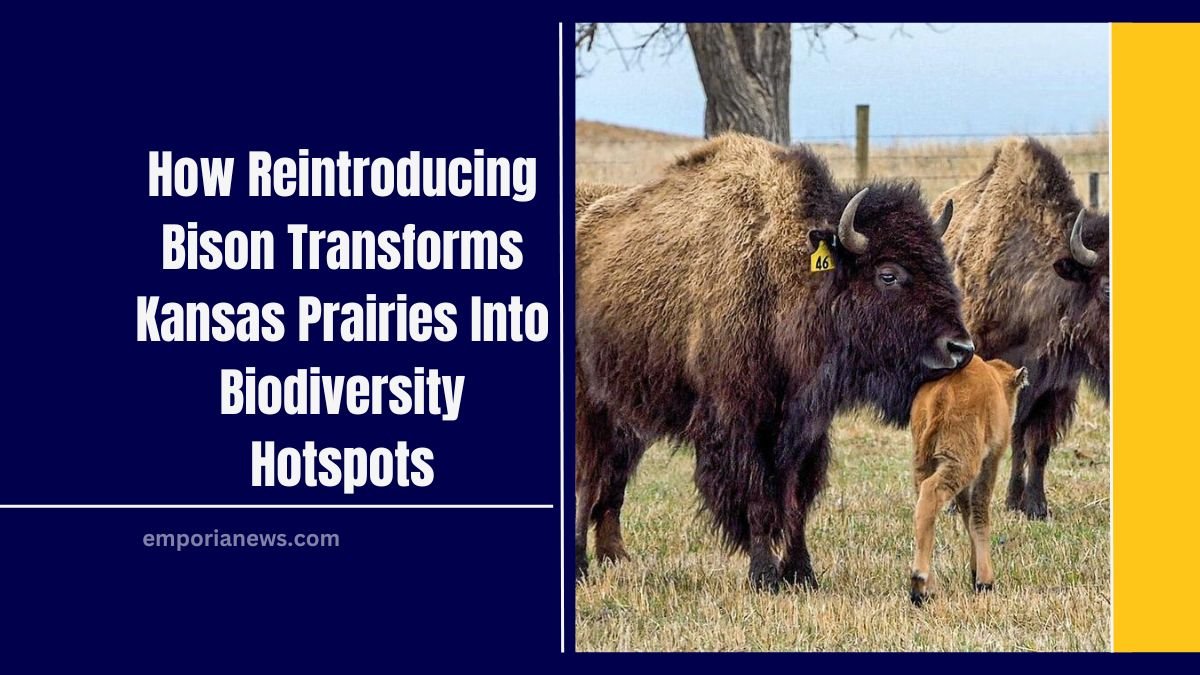The reintroduction of bison to Kansas tallgrass prairies is not only a step toward restoring ecological balance but also a significant driver of biodiversity and resilience.
A Kansas State University study spanning 29 years has highlighted the profound impact bison have on native plant species and their ability to withstand extreme climate events.
Bison and Biodiversity in Tallgrass Prairies
Bison grazing has been found to double biodiversity compared to areas grazed by cattle or left ungrazed. Native species diversity increased between 0.58 and 1.06 species per year in bison-grazed areas, while cattle grazing achieved only half this rate.
Key factors contributing to this difference include:
- Grazing Habits: Bison graze year-round, unlike cattle that primarily graze during growing seasons.
- Grazing Lawns: Bison create “grazing lawns” that clear dominant grass cover, allowing space for diverse native plants to flourish.
- Dominant Grass Reduction: While dominant grasses are reduced, they are not eliminated, maintaining a balanced ecosystem.
Resilience During Drought Events
The study also evaluated the prairies’ response to severe drought conditions, particularly during the extreme droughts of 2011 and 2012. Findings revealed:
- Rapid Recovery: Bison-grazed areas rebounded to pre-drought levels within two to four years, significantly faster than cattle-grazed or ungrazed areas.
- Enhanced Water Utilization: Biodiverse species in bison-grazed areas accessed deeper soil water, reducing competition for surface water and enhancing drought resilience.
- Ecological Resilience: The resilience observed aligns with the theory that greater biodiversity fosters ecological stability, a critical factor in the face of increasing climate extremes.
Comparison of Grazing Systems
While cattle grazing also promotes biodiversity, its impact is less pronounced than that of bison. Cattle lack the year-round grazing patterns and lawn-forming behaviors that make bison so effective at creating conditions for diverse plant growth.
| Factor | Bison Grazing | Cattle Grazing | Ungrazed Areas |
|---|---|---|---|
| Grazing Season | Year-round | Growing season only | None |
| Biodiversity Impact | Doubles native species | Increases by half | Minimal |
| Dominant Grass Reduction | Significant but balanced | Moderate | None |
| Drought Resilience | Rapid recovery (2-4 years) | Slower recovery | Lowest resilience |
| Water Utilization | Deeper soil water reliance | Shallow and competitive use | Heavy reliance on shallow water |
Historical Context of Bison in Kansas
Historically, millions of bison roamed the Great Plains, shaping the landscape through their grazing patterns.
However, bison populations were decimated by the late 1800s due to pioneer settlements. Today, only about 5,000 bison remain in Kansas, primarily in managed areas.
The absence of bison has likely led to a substantial reduction in grassland biodiversity. Researchers advocate for the “rewilding” of bison to restore the ecological balance of the tallgrass prairies.
Future Implications of Rewilding Bison
Reintroducing bison to grasslands offers a promising solution to combat biodiversity loss and adapt to the challenges of climate change.
The Kansas State University study underscores the potential of bison to not only enhance biodiversity but also create resilient ecosystems capable of withstanding extreme environmental events.
Reintroducing bison to Kansas tallgrass prairies is a vital step toward restoring ecological balance. Their grazing patterns double biodiversity and enhance resilience to extreme weather events like droughts.
With only 5,000 bison remaining, rewilding efforts could transform Kansas’ grasslands into thriving ecosystems, providing both environmental and climate-related benefits.
As the study shows, biodiversity and resilience go hand in hand, making bison a critical player in ecological restoration.
FAQs
Why are bison more effective than cattle in promoting biodiversity?
Bison graze year-round and create grazing lawns that reduce dominant grasses, providing space for diverse native species. Cattle grazing is seasonal and lacks the same ecological impact.
How do bison-grazed areas recover from drought faster?
Biodiverse species in bison-grazed areas utilize deeper soil water, reducing competition and enabling quicker recovery to pre-drought conditions.
What is the current population of bison in Kansas?
There are approximately 5,000 bison in Kansas today, primarily in managed areas, compared to millions in the past before their near extinction.




